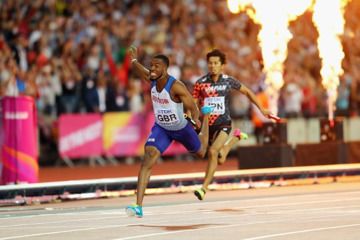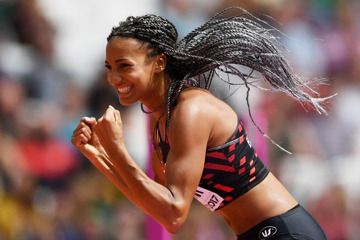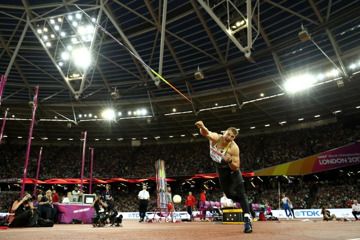Mutaz Essa Barshim in the high jump at the IAAF World Championships London 2017 (© Getty Images)
Our end-of-year review series continues as statisticians A Lennart Julin and Mirko Jalava look back on the best jumping performances of the year.
Men’s high jump
After the extraordinary 2014, the event has settled down with only Mutaz Essa Barshim still being able to – occasionally – clear heights of 2.40m or higher.
Looking back at the past 20 years of high jumping, the anomaly of 2014 becomes clear: 10th and 25th place in the year lists have been strikingly consistent all through these two decades while the number of 2.40m-plus performances has ranged from zero to three – apart from 2014 when there were 16.
Jumping 2.40m is obviously mainly a physical challenge which few people will ever be capable to master, especially on any kind of regular basis.
Barshim has proven to be such an exception and his current total of 2.40m-plus meets standing at 11 gives him a clear No.2 position behind Javier Sotomayor’s 20 and with third placer Bogdan Bondarenko at seven. Bondarenko is still competing but, hampered by injuries, hasn’t been able to jump higher than 2.37m since 2014.
Barshim might still soon experience challenges to his supremacy. First in line seems to be Danil Lysenko who at age 20 took silver in London and raised his PB to 2.38m. And there was an extremely exciting European U20 Championships where Maksim Nedasekau, Tom Gale and Dmytro Nikitin pushed each other to new heights: Nedasekau’s PB went from 2.26m to 2.33m, Gale’s from 2.23m to 2.28m and Nikitin’s from 2.18m to 2.28m.
Men’s pole vault
The pole vault got a new ‘king’ as Renaud Lavillenie – after almost a decade as the main force, as illustrated by seven straight IAAF Diamond League titles – was replaced by Sam Kendricks.
The US vaulter showed remarkable reliability: 17 competitions, all wins. And in all but four minor meetings, he cleared at least 5.80m. Kendricks also became the 22nd member of the six-metre club when he cleared 6.00m at the US Championships in June.
Member No.21 joined during the indoor season when Poland’s Piotr Lisek surpassed the barrier in a shopping-mall competition. Lisek carried his winter form through to outdoors to take silver in London and tie for second place at the IAAF Diamond League final.
The dethroned king, Lavillenie, still jumped well – compiling nine meets at 5.80m or higher – but he wasn’t the winner like before, having to settle for third place at the World Championships and at the IAAF Diamond League final.
For Olympic champion Thiago Braz, however, injury meant that 2017 became a year he will want to quickly forget. But for Armand Duplantis, the 2017 memories will be cherished as he improved by a whopping 39 centimetres to a world U20 record of 5.90m. That propelled him from talented youngster to someone capable of mixing it up with the top seniors, which he confirmed by finishing ninth in London.
That Duplantis ultimately would be vaulting great heights was expected after all his age records. But not that it would happen already at age 17.
Men’s long jump
It has been a long and winding career road for Luvo Manyonga but in 2017, at age 25, he finally arrived to claim the top position.
And there was no argument whatsoever concerning that status: Manyonga compiled a perfect season, staying undefeated through nine meetings with his winning performance averaging 8.52m while the No.2 on the world list had a best mark of 8.49m.
This season very much belonged to South Africa as Manyonga’s main opponent was compatriot Ruswahl Samaai who showed consistency at the 8.30m level but who still was 0-6 against Manyonga. The only real challenge to the South Africans came from US champion Jarrion Lawson who in London managed to squeeze into the silver position.
Lawson aside, it was something of an off-year for the US long jumping as Olympic champion Jeff Henderson never found his best form. China, meanwhile, seems to possess some kind of conveyor-belt production method for young and globally competitive jumpers.
At the 2015 World Championships, Wang Jianan (then aged 18), Gao Xinglong (21) and Li Jinzhe finished third to fifth. At the 2016 Olympics Wang (aged 19) and Huang Changzhou (22) were fifth and 11th respectively, while in London this year Shi Yuhao (still 18) and Wang (now 20) ended up sixth and seventh.
The long Cuban tradition was revived as world U20 champion Maykel Massó finished fifth in London, just six centimetres from a medal. Aleksandr Menkov also returned, achieving his best championship finish (fourth) since becoming world champion four years ago.
Men’s triple jump
In the triple jump, the main man once again was Christian Taylor, who seems to be well on his way to a legacy as one of the all-time-greats.
His win in London constituted his fifth global outdoor title since 2011 and his average season’s for the past seven years stands at 17.81m.
Apart from his world-leading 18.11m, this year Taylor never could find the form necessary to – like in 2015 – seriously threaten Jonathan Edwards’s longstanding world record. But his form was still good enough to once more fend off the challenges from long-time rival Will Claye when it mattered at the World Championships and in the IAAF Diamond League.
This year also saw – after one year of absence – the return of Pedro Pablo Pichardo, whose exciting match-ups with Taylor in 2015 remains one of the highlights of that year.
Pichardo – who did not compete at the World Championships – was not back to full strength but was good enough to defeat both Taylor and Claye at the IAAF Diamond League meeting in Lausanne. And despite Pichardo’s absence, Cuba remained a main player in London thanks to teenager Christian Nápoles in fourth and Andy Diaz in seventh.
The surprise at the World Championships was the bronze medal at age 33 for Nelson Évora. The Portuguese jumper has struggled with injuries since he won his world and Olympic titles in 2007-2008, but his 17.19m leap in London was his best outdoors for two years.
Women’s high jump
In 2016 the Olympic title was won with a leap of 1.97m, but in 2017 it soon become clear that a result that low would not get the job done in London.
Maria Lasitskene, competing as an authorised neutral athlete, cleared 2.00m for the first time in mid-January and went even higher with 2.03m at the Russian Indoor Championships in February.
Her season was perfect from start to finish with 24 wins in as many competitions, and she cleared 2.00m an incredible 15 times during 2017. She jumped a world-leading 2.03m in her first outdoor competition in Eugene and then 2.04m in Hengelo just two weeks later. Another 2.06m world lead was set in Lausanne in July and she followed it with 2.05m in Monaco just three weeks before the IAAF World Championships.
In London there was one slight glitch during the competition when Lasitskene failed her first attempt at 1.99m with Yuliya Levchenko clearing with her first for a brief lead. The Ukrainian, just 19 years of age at the time of the IAAF World Championships, had come to the competition with a personal best of just 1.97m. But Lasitskene quickly corrected the problem, flying over 2.01m with her first try while Levchenko cleared the height with her second attempt, her third personal best during the competition and the first two-metre jump of her career.
The Russian also cleared 2.03m with her first try and then failed three attempts at 2.08m. Levchenko was the surprise silver medallist at 2.01m and Poland’s Kamila Licwinko equalled her outdoor personal best at 1.99m for the bronze medal.
Lasitskene, of course, also won the IAAF Diamond League title in this event, winning all six competitions she took part in.
Women’s pole vault
Having taken the reins when winning the Olympic title in 2016, Ekaterini Stefanidi emerged as the clear No.1 pole vaulter during 2017.
The Greek was almost unbeaten for the entire year. Just one loss in 16 finals during the season and that came early, in her second indoor meeting of the season in Clermont-Ferrand, where Sandi Morris won.
Stefanídi won her first big meeting of the season in Belgrade in March where she grabbed her first European indoor title with 4.85m. Outdoors she was extremely consistent and won the first outdoor competition in Doha with 4.80m. A further 4.85m world lead in Rome and a 4.81m win at the IAAF Diamond League meeting in London showed Stefanidi was ready for the IAAF World Championships.
In London there was no question about her abilities; one jump in qualification and then a clean sheet in the final until 4.82m and she had won the competition. Stefanidi failed her first attempt at 4.89m, but then raised the bar to a national record height of 4.91m, which she cleared with her first try for a world lead.
Stefanidi won three more IAAF Diamond League meetings in Birmingham (4.75m), indoors at the Hauptbahnhof in Zurich (4.87m) and was crowned the IAAF Diamond League champion when winning in Brussels with another 4.85m clearance in September.
Morris, a 5.00m jumper in 2016, did not reach the same heights in 2017 as she did last year, but was still the silver medallist in London with 4.75m. She also cleared 4.87m indoors in Zurich, only losing to Stefanidi in countback.
The bronze medal in London was awarded with a relatively modest 4.65m, shared by Cuba’s 2015 world champion Yarisley Silva and surprise performer Rosbeilys Peinado of Venezuela, just 19 years old.
Women’s long jump
This event started the year with a blast as Serbia’s Olympic bronze medallist Ivana Spanovic produced a stunning performance to retain her European indoor title on home soil in Belgrade.
The 27-year-old reached her first seven-metre jump in the qualification round with 7.03m. She then went on to jump the three longest jumps of the whole year in the final: 7.16m, a 7.24m national indoor record, and 7.17m.
Outdoors didn’t turn out quite so well for the Serbian as she suffered an injury just two weeks before the start of her outdoor campaign. Spanovic was only able to compete twice before the IAAF World Championships, winning in Lausanne in July with 6.79m and placing second at the IAAF Diamond League meeting in London with a 6.88m season’s best.
USA’s Brittney Reese was the world leader before London with 7.13m from Chula Vista in June. The 31-year-old, who won three consecutive world titles 2009-2013, also won in Eugene at the Prefontaine Classic with 7.01m in May.
Defending world champion Tianna Bartoletta was the other athlete beyond seven metres outdoors before London, having won the US title with a wind-aided 7.05m and a wind-legal 7.01m in the series. The 32-year-old also won in London at the IAAF Diamond League meeting, equalling her season’s best of 7.01m.
Following a rather low quality qualification, the final in London at the IAAF World Championships was tight. Reese jumped 7.02m in round three, but there was big controversy when Spanovic, in third place with 6.96m before the last round, looked to have won the gold with her last jump, but the scoreboard showed only 6.91m. The number on her back flapped loose and had touched the sand at 6.91m and the Serbian finished fourth.
Reese held on to the win, adding a fourth world title to her résumé, neutral athlete Darya Klishina surprised everyone with a 7.00m season’s best for the silver and Bartoletta jumped 6.97m to steal the bronze by one centimetre ahead of Spanovic, who won the IAAF Diamond League title in this event.
Women’s triple jump
After making a huge breakthrough in 2016 to take the Olympic silver medal, Yulimar Rojas quickly took reign of the women’s triple jump in 2017 from Colombian Caterine Ibarguen, who had won three global titles between 2013 and 2016.
Although the 15-metre line was not surpassed during 2017, Rojas was the world-leading athlete both indoors and outdoors, jumping 14.79m indoors and leaping 14.96m in Andújar in June.
Brazil’s Nubia Soares was the surprise winner at the South American Championships in Asunción, beating Ibarguen with a wind-assisted 14.42m, but Ibarguen rebounded with a win over Rojas in Monaco, 14.86m to 14.83m.
The World Championships final was extremely tight. Rojas took the lead in round two with 14.82m, but Ibarguen quickly answered with 14.89m. In round five the Venezuelan went back to the lead, jumping 14.91m, and while Ibarguen came really close to winning her third consecutive world title, her last jump was measured at 14.88m and she just fell short of the gold medal.
Olga Rypakova found her best form at the right time. The 33-year-old from Kazakhstan, who won the Olympic bronze in 2016 and was crowned Olympic champion in 2012, jumped a season’s best of 14.77m, which was enough for her second straight bronze medal at the IAAF World Championships. Rypakova was also crowned the IAAF Diamond League champion in this event.
Mirko Jalava (women’s events) and A Lennart Julin (men’s events) for the IAAF







